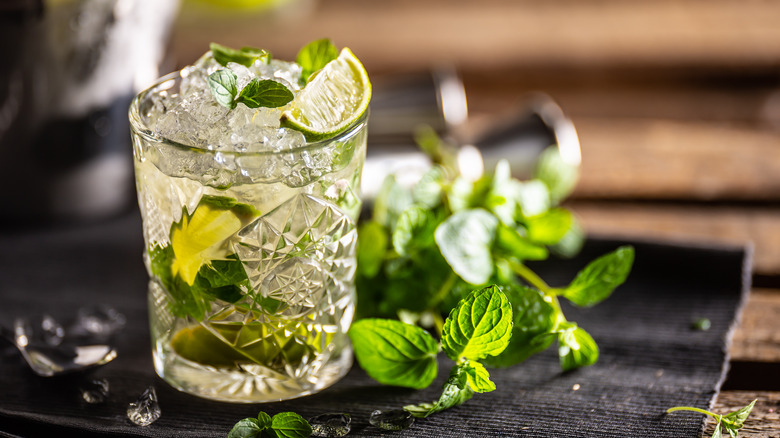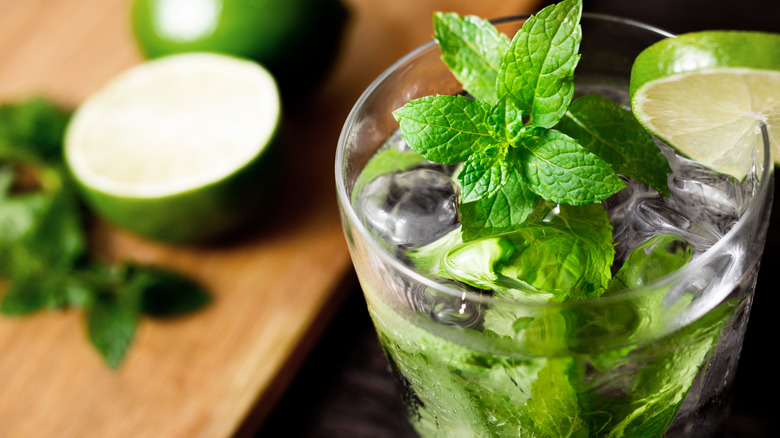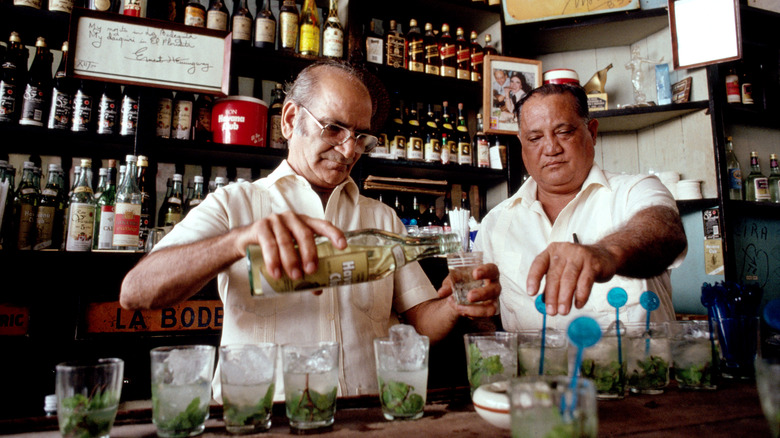The Origin Story Of The Mojito
Many versions have been proposed regarding the origin of the mojito cocktail recipe. Various sources, including bartenders, rum brands, 16th-century English explorers, and enslaved African people, have been credited with the creation of this iconic rum-based beverage featuring lime, mint, sugar, and soda water.
What all variations of the origin story seem to agree on, however, is that the drink was first created in Havana, Cuba. The specifics of when and by whom depend on the narrator. The definition of a mojito also plays a significant role, as, until at least the mid-19th century, early versions of the now-iconic Cuban cocktail were not made with rum but with aguardiente, a sugarcane-distilled liquor popular in Latin America. English sea captain Sir Francis Drake, for example, is credited with one of these early versions, a medicinal concoction inspired by his 1586 visit to the Caribbean island, intended to prevent cholera and named in his honor: Draque (also known as Drake).
Meanwhile, the first evidence of the modern version of the mojito is found at Sloppy Joe's, the once legendary Havana nightspot that featured the mojito, by that name, in its souvenir menu book as far back as 1931.
How the mojito evolved to its present form
Just as the margarita's origin story includes a theory that it evolved in Baja California from an earlier cocktail called the tequila daisy (with "daisy" translating to "margarita" in Spanish), there is a case to be made that the mojito's appearance at Havana nightspots like Sloppy Joe's and La Bodeguita del Medio was the result of a similar evolution — not from the Draque, but rather from the mint julep. Although the latter uses bourbon instead of rum, its introduction to Havana during the Prohibition Era by visiting Americans has been cited as a potential influence on the mojito. It's important to note that both drinks heavily rely on sugar-muddled mint for flavor.
Rum giant Bacardi, originally founded in Cuba and later relocating its operations post-Cuban Revolution, has been acknowledged for promoting the mojito during its early years. The transition from aguardiente to rum as the primary ingredient in mojitos is attributed to Bacardi's rise as a brand in the mid-19th century. Interestingly, the cocktail was alternately referred to as mojito or mojo, with "mojo" being an African term for "magic spell." In 1931, the same year Sloppy Joe's published the earliest known mojito recipe, a book titled "Cuban Cookery" featured a recipe for a Cuban mojo, which contained the exact ingredients as a classic mojito: rum, mint, sugar, lime, and soda water. Ultimately, it was "mojito" that became the enduring name.
Celebrities and media helped to popularize the mojito
In the 21st century, the mojito remains one of the world's most perennially popular cocktails, frequently featured in popular Hollywood films due to its summery flavors. For instance, in the 2002 thriller "Die Another Day," Pierce Brosnan's James Bond opts for a mojito over his usual shaken vodka martini while in Cuba with Halle Berry. Similarly, in the 2006 action film "Miami Vice," Colin Farrell and Gong Li's characters make a trip to Cuba by speedboat and discover how a proper mojito is made.
This trend of high-profile celebrity endorsements is not new; it played a significant role in popularizing the cocktail during the 20th century. Nobel Prize-winning author and former Cuban resident Ernest Hemingway famously endorsed drinking mojitos at La Bodeguita del Medio, which is the same establishment Gong Li's character aims to visit in "Miami Vice." Although the mojito wasn't invented there, La Bodeguita del Medio, more than eighty years after its 1942 opening, continues to be a pilgrimage site for mojito aficionados. Throughout its history, the bar has welcomed renowned figures from various fields, including Chilean poet Pablo Neruda, actor Errol Flynn, and American singer Nat King Cole.



